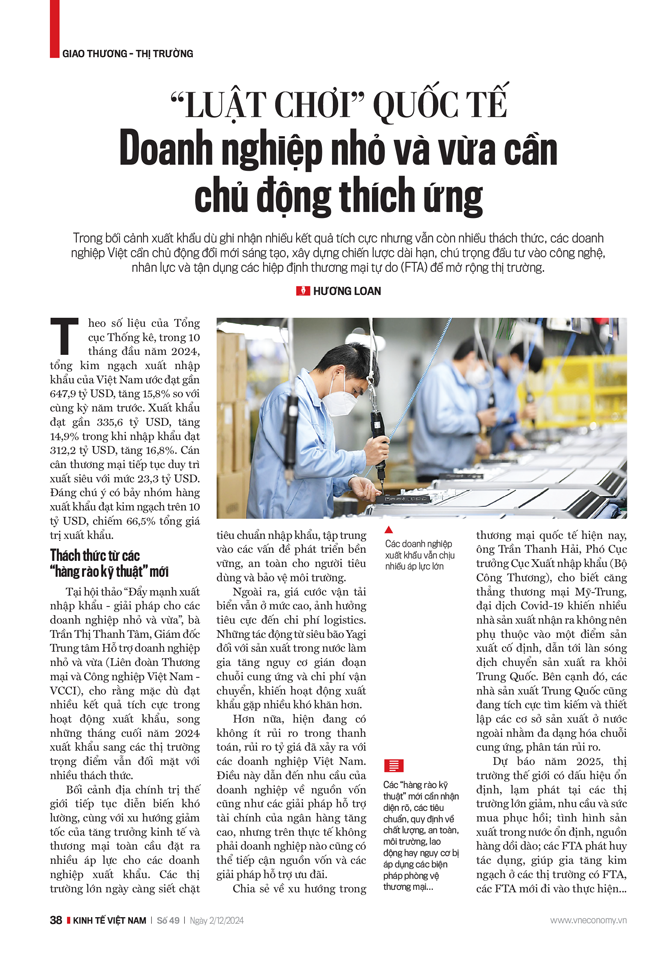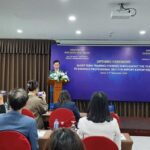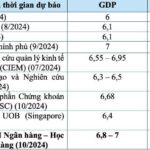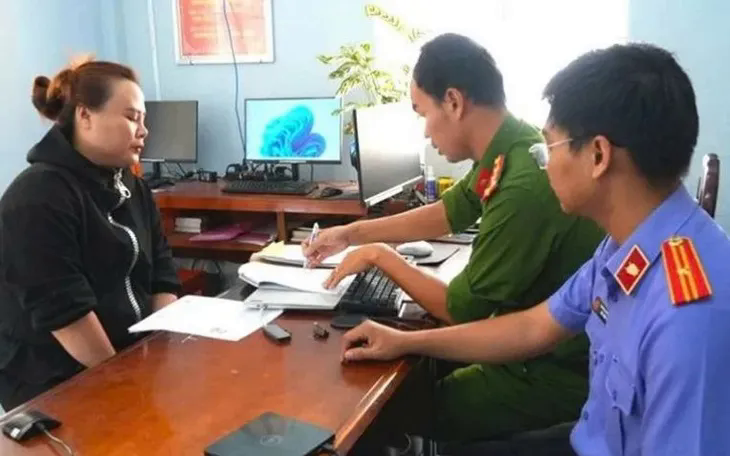Vietnam’s Trade Performance: Overcoming Technical Barriers for Sustained Growth
According to statistics from the General Statistics Office, in the first ten months of 2024, Vietnam’s total import and export turnover is estimated to reach nearly $647.9 billion, a 15.8% increase compared to the same period last year. Exports reached nearly $335.6 billion, a 14.9% increase, while imports reached $312.2 billion, a 16.8% increase. The trade balance continues to maintain a surplus of $23.3 billion. Notably, seven export commodity groups achieved a turnover of over $10 billion, accounting for 66.5% of the total export value.
CHALLENGES FROM NEW “TECHNICAL BARRIERS”
At the workshop on “Promoting Import and Export – Solutions for Small and Medium-sized Enterprises,” Ms. Tran Thi Thanh Tam, Director of the Small and Medium Enterprise Support Center (Vietnam Chamber of Commerce and Industry – VCCI), stated that despite positive results in export activities, exports to key markets in the last months of 2024 still face many challenges.
The unpredictable geopolitical backdrop, coupled with the decelerating global economic and trade growth, poses significant pressure on export enterprises. Major markets are tightening import standards, focusing on sustainable development, consumer safety, and environmental protection.
Additionally, sea freight rates remain high, negatively impacting logistics costs. The impacts of Super Typhoon Yagi on domestic production increase the risk of supply chain disruptions and transportation costs, making export activities more challenging.
Furthermore, there are considerable risks in payment and currency exchange rates that Vietnamese enterprises have encountered. This has led to increased demand for capital and financial support solutions from banks. However, not all businesses can access capital and preferential support solutions.
Sharing insights on current trends in international trade, Mr. Tran Thanh Hai, Deputy Director of the Import-Export Department (Ministry of Industry and Trade), mentioned that the US-China trade tensions and the Covid-19 pandemic made many manufacturers realize the risks of relying on a single fixed production location, triggering a wave of production shifts out of China. Meanwhile, Chinese producers are actively seeking and establishing overseas production bases to diversify their supply chains and mitigate risks.
It is forecasted that in 2025, the world market will show signs of stability, inflation in major markets will decrease, and demand and purchasing power will recover. Domestic production is expected to stabilize, with abundant supply sources, and FTAs will take effect, boosting turnover in markets with FTAs, and new FTAs will be implemented. Therefore, it is predicted that import and export activities will maintain a good growth momentum from now until Q1/2025, with balanced growth across commodity groups and markets.
However, the challenges lie in identifying these new “technical barriers,” including standards and regulations related to quality, safety, the environment, labor, and the risk of facing trade remedy measures…
Mr. Nguyen Anh Duong, Head of the Comprehensive Research Department, Central Institute for Economic Management (CIEM), pointed out that while global economic recovery and the network of FTAs have created opportunities to increase exports, in line with the recovery of the supply chain in Asia, there are challenges from the trend of sustainable development and the increase in trade remedies in many markets. Meanwhile, the green transition process of domestic enterprises is relatively slow, affecting their ability to adapt to sustainable development regulations in some major markets.
TAKING THE INITIATIVE WITH INNOVATION AND TECHNOLOGY INVESTMENT
Difficulties in accessing capital, especially green credit, lead to increased cost pressure and foreign exchange rate risks. Accessing capital according to the value chain is not yet popular in Vietnam, and manufacturing enterprises still rely mainly on commercial bank credit, while capital mobilization through the stock market is modest.
Enterprises face challenges in accessing foreign currency loans to import inputs, auxiliary materials, and equipment for production and export, while the current legal regulations only focus on a few forms, such as payment envelopes and letters of credit…
To boost exports, Mr. Nguyen Anh Duong suggested that small and medium-sized enterprises proactively study new regulations in target markets and develop response plans. They should embrace innovation and build long-term strategies, invest in technology and human resources, and leverage FTAs to expand their markets. Additionally, enterprises need to focus on digital technology application to enhance competitiveness and professionalism and implement contingency plans to minimize risks from market fluctuations.
Furthermore, businesses should explore and implement new business models (such as circular and digital economies) and particularly enhance experience sharing in adapting to new trends and regulations related to green development, environmental protection, such as the Carbon Border Adjustment Mechanism (CBAM), the EU Deforestation Regulation (EUDR), and personal data protection… in major markets. Simultaneously, propose appropriate technical support from partners (it is challenging for government agencies to provide specific support proposals from partners)
From the government’s perspective, Mr. Duong suggested actively monitoring and evaluating new trends and regulations to provide relevant information to the business community. Guide enterprises to develop strategies to maximize the benefits of FTAs, provide appropriate support without violating international commitments, and align with international treaties.
Simultaneously, develop programs and initiatives to help businesses engage deeper into global and regional value chains. Research and propose solutions that adapt to new trends (harmonizing international standards while considering the adaptability of domestic enterprises). Participate in establishing international rules suitable for digital transformation and green transition…
According to Mr. Lam Duc Thuan, Vice Head of the Management Board of Industrial Parks in Hung Yen Province, enterprises must seize opportunities and implement innovative solutions with the right direction and practical approach to market access and competitiveness enhancement.
Mr. Tran Thanh Hai emphasized that small and medium-sized enterprises should establish long-term business orientations and plans, focusing on competition in the context of market openness. They should promote trade promotion, utilize government support, understand and take advantage of FTAs to expand export markets, invest in human resources development and digital technology application… In addition, it is crucial to have contingency plans to address incidents, risks, and fluctuations in the market and be vigilant against fraudulent and deceptive acts in international trade.
In the field of logistics, Mr. Ngo Khac Le, Vice Secretary-General of the Vietnam Logistics Services Enterprises Association (VLA), recommended that enterprises implement flexible warehouse solutions, utilize bonded warehouses, and shared warehouses to reduce storage costs and expedite cargo handling… Optimize transportation routes and modes by combining multimodal transport (sea, air, road, and rail) to optimize costs and transportation time.
Moreover, enterprises should focus on supply chain risk management, establish contingency plans to minimize risks in the event of unforeseen incidents such as oil price fluctuations and natural disasters… Collaborate with other enterprises in using logistics services and cooperate with partners in the supply chain to leverage scale advantages and create a strong network of cargo owners…
At the event, delegates proposed that the State should actively develop mechanisms and policies adapted to global trends. Providing information on new technical standards, guiding enterprises to take advantage of FTAs, and creating initiatives to help businesses engage deeper into value chains are top priorities.
The banking sector needs to be more proactive in providing smart and flexible financial solutions to ensure capital for export activities. Prioritize lending to the import-export sector and develop appropriate credit products to help enterprises optimize costs…
https://postenp.phaha.vn/chi-tiet-toa-soan/tap-chi-kinh-te-viet-nam

“Vietnam: A Global Powerhouse in Trade and Commerce”
Once a minor player in global trade, Vietnam has emerged as a significant exporter, climbing to 11th place in the ranking of the world’s top 15 exporters by 2023, a remarkable achievement considering its absence from the top 15 before 2013. Vietnam’s rapid rise has caught the attention of the international trade community, earning it the title of a surprising powerhouse in global commerce.
The Yearly Inflation Forecast for 2024: A Modest Rise of 4%
Inflation forecasts for 2024 are estimated to reach 4 to 4.5%, surpassing 2023 levels due to the significant surge in global energy and food prices. This projection underscores the critical need for businesses and consumers alike to brace for a potentially challenging economic landscape in the coming year. With inflationary pressures showing no signs of abating, proactive strategies and adaptive approaches will be essential to navigate the financial climate ahead.
Counterfeit Signature Scam: The Dark Side of Overseas Employment
Scammers have been impersonating official documents with the signature of the Minister of Labour, Invalids and Social Affairs, even going as far as using images of the Ministry’s leaders working with foreign partners to gain the trust of unsuspecting job seekers looking for employment abroad.
“Vietnam: The Rising E-Commerce Dragon of Southeast Asia”
The Vietnamese e-commerce market is projected to experience a compound annual growth rate (CAGR) of 28% from 2025 to 2033, underpinned by rising internet and mobile penetration, and the increasing adoption of digital payments. The government’s digitalization agenda is also a key driver of this impressive growth trajectory, setting the stage for a vibrant and dynamic online retail landscape in Vietnam.
Unveiling the Counterfeit: Over 50,000 Fake Red Bull Cans Uncovered
The Market Management Force has recently uncovered over 50,000 cans of a beverage named “Bò Húc”, which bears a striking resemblance to the well-known energy drink, Red Bull. This discovery raises concerns about potential trademark infringement, as the similarities between the two products are undeniable. With a name that translates to “Bull Charge”, it is clear that this beverage aims to capitalize on the reputation and success of Red Bull.





















